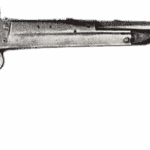
Introduction: Innovation at a Crossroads
In the 1860s, as nations reeled from the shock of industrial warfare and scrambled to modernize their armies, a curious firearm quietly entered service with two very different militaries: the Union Army of the United States and the Austrian Empire. Known today as the Austrian Lindner Carbine, this weapon embodied the improvisational spirit of its era. Born from the mind of German-American inventor Edward Lindner, and briefly fielded on both sides of the Atlantic, the Lindner Carbine attempted to drag obsolete muzzle-loaders into the breech-loading age. Though ultimately outpaced by metallic cartridge technology, it remains a compelling artifact of transition, ingenuity, and martial pragmatism.
Edward Lindner: The Inventive Immigrant
Edward Lindner was a German-born inventor who settled in Michigan prior to the American Civil War. A gunsmith by trade and a mechanical thinker by inclination, Lindner was driven by the same wartime urgency that spurred dozens of inventors to improve the soldier's toolkit. He secured U.S. Patent No. 33,748 on November 26, 1861, for a breechloading conversion system that allowed a muzzle-loading rifle to be adapted to accept paper cartridges from the rear via a swiveling breechblock.
Lindner’s system was relatively simple, requiring minimal alteration to existing arms. The breechblock, mounted on a horizontal axis, could be swung open to the right, allowing a paper cartridge to be inserted directly into the chamber. Once closed and capped, the rifle could be fired like any percussion gun. While not as advanced as repeaters or metallic cartridge arms, Lindner’s design was faster and more versatile than traditional muzzle-loaders.
Austrian Interest: Bridging the Technological Gap
In the aftermath of its defeat in the Second Italian War of Independence (1859), the Austrian Empire recognized the pressing need to modernize its small arms. The standard Lorenz Model 1854 rifle, while accurate and well-crafted, was a muzzle-loader at a time when breech-loading technology was rapidly evolving. Rather than discard existing stockpiles, Austria experimented with conversion systems, including Lindner’s design.
By approximately 1862, Austrian military authorities had procured several thousand Lindner breech mechanisms, which were installed on a combination of standard-length Lorenz rifles and carbine-length barrels, likely intended for cavalry or specialized infantry. While no official designation such as "Austrian Lindner Carbine" existed at the time, the term is used by modern collectors to refer to these compact, breech-converted arms.
Estimated Production: Based on surviving examples and secondary documentation, historians estimate that between 6,000 and 7,500 Lindner-converted firearms were produced in Austria, though precise records are lacking. Most appear to have remained in depot or reserve units rather than being issued en masse.
Field Use in the U.S. Civil War
Approximately 500 First Model Lindner carbines were delivered early in the war, primarily issuing them to the 1st Michigan Cavalry. Early reports noted the carbine’s increased rate of fire and ease of use from the saddle. However, field feedback also highlighted issues with fouling, loose breech seals that leaked gas, and maintenance difficulties in harsh conditions. Another 6,000 Second Model Lindner carbines were contracted and produced later, though relatively few saw widespread issue.
While never deployed widely, Lindner rifles offered a marginal improvement over muzzle-loaders during a critical phase of Union armament development. By 1864, they had been largely phased out in favor of metallic cartridge repeaters and more reliable single-shot carbines.
Technical Overview
| Feature | Specification |
|---|---|
| Caliber | .54 (13.9mm) |
| Barrel Length | Approx. 22–24 inches (carbine variant) |
| Action | Swiveling breechblock |
| Ignition | Percussion cap |
| Ammunition | Paper cartridge |
| Rate of Fire | 8–10 rounds per minute (trained user) |
| Sights | Adjustable rear, fixed front blade |
The design allowed loading while prone or mounted, a major advantage over muzzle-loaders. However, the system’s lack of a gas-tight seal and its reliance on fragile paper cartridges limited its long-term viability.
Comparison to Other Civil War Carbines
| Feature | Lindner Carbine | Sharps Carbine | Spencer Carbine | Burnside Carbine | Gallagher Carbine |
|---|---|---|---|---|---|
| Type | Breechloader (paper) | Breechloader (paper) | Repeater (metallic) | Breechloader (brass) | Breechloader (brass) |
| Rate of Fire | 8–10 rpm | ~10 rpm | ~14–20 rpm | ~8–10 rpm | ~8 rpm |
| Gas Seal | Poor | Fair | Good | Excellent | Fair |
| Combat Proven | Limited | Extensive | Extensive | Widespread | Limited |
Compared to the Spencer, the Lindner was antiquated by 1863. Even the single-shot Burnside offered superior reliability and ballistic efficiency due to its proprietary metallic cartridge. The Lindner's place in history is thus more about adaptation than advancement.
Legacy and Rarity
Today, surviving Lindner rifles and carbines are rare and command significant interest among collectors of Civil War and Austrian military arms. Many specimens show hybrid features of the Lorenz and Lindner systems, with distinctively machined breechblocks and shortened barrels.
Collectors should note that these arms were not always marked distinctly, and authentication often relies on the construction of the breech, barrel proofs, and surviving documentation. U.S.-issued Lindners occasionally appear with Ordnance inspection marks and are generally easier to trace.
Frequently Asked Questions (FAQ)
Was the Lindner Carbine used in combat?
Yes, it saw limited use with the 1st Michigan Cavalry in the early years of the Civil War. Austrian use in combat is possible but not definitively documented.
What caliber is the Lindner Carbine?
It is chambered in .54 caliber (13.9mm), typically using paper cartridges compatible with Lorenz rifles.
Was it a repeater?
No. The Lindner Carbine is a single-shot breechloader. While faster than muzzle-loaders, it was outclassed by repeaters like the Spencer.
Where can I see a Lindner Carbine today?
Examples of the Lindner Carbine exist in the Springfield Armory National Historic Site and private collections. Occasionally, they appear in specialty firearms auctions.
Primary Sources and Further Reading:
- U.S. Ordnance Department Reports (1861–1863)
- Edward Lindner, U.S. Patent No. 33,748 (1861)
- "The Austrian Army, 1836–1866: Firearms and Tactics," Austrian Military Archives, Vienna
- McAulay, John D. Carbines of the Civil War (1997)
- Todd, Frederick P. American Military Equipage, 1851–1872
Read more about the Lindner Carbine here:

If you know of any forums or sites that should be referenced on this listing, please let us know here.




